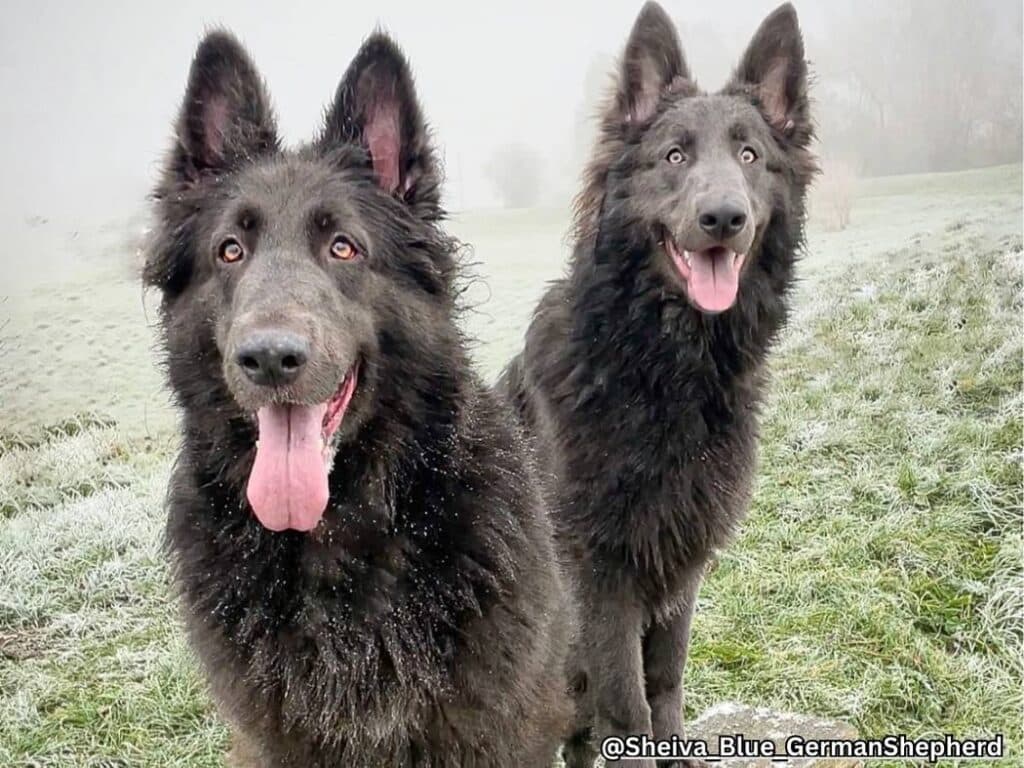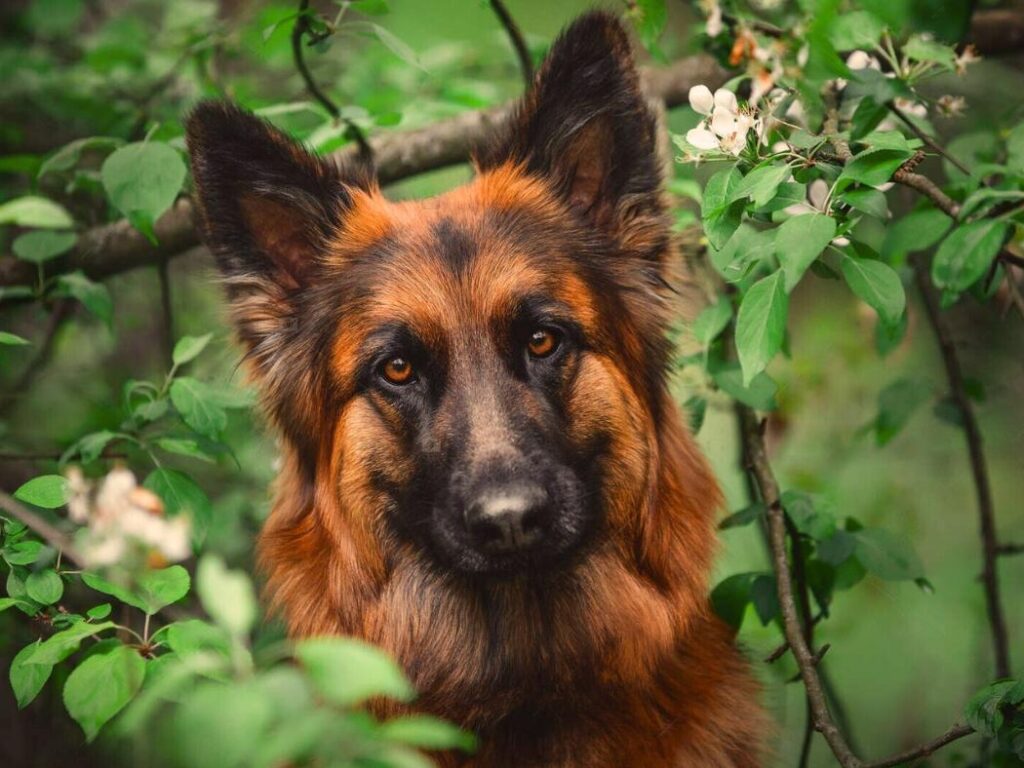While their name might evoke images of solid blue coats, the Blue German Shepherd is in fact a diluted version of the traditional black German Shepherd.
They possess the same intelligence and loyalty as their traditional counterparts.
From their price and genetics to their temperament and care requirements, we’ll leave no stone unturned. Whether you’re considering adding a Blue German Shepherd to your family or simply curious about this captivating color variation, you’ve come to the right place.
Key Takeaways
- Blue German Shepherds are not a separate breed, they are a variation in the coat color within the German Shepherd breed.
- Blue GSDs are extremely rare and may cost $1500 to $2500 or even higher.
- Blue GSDs are as healthy as standard German Shepherds and are not prone to any specific health problem because of the blue color.
- Their temperament & behavior are also not influenced because of the color variation.
- The best source for purchasing a Blue GSD is from breeders who specialize in breeding these distinctive puppies.

Source: @blue_the_gsd
What is a Blue German Shepherd?
Blue German Shepherds are a variant of the traditional German Shepherd breed, characterized by a distinct deep, steely gray tone in their fur. This unique coloration results from the presence of a pair of “dilution” genes, which lighten the black fur to create a distinctive blue hue.
This breed not only exhibits blue fur but also possesses blue noses, setting them apart from regular gray German Shepherds.
While their color may differ, these dogs share the same qualities as their standard counterparts, including intelligence, loyalty, and versatility, making them suitable companions with a distinctive and eye-catching appearance.
It’s important to note that the Blue GSDs are not specifically sky-blue, deep blue, or solid blue, rather they are faded black that looks like blue.
So, if you’re considering adding a blue GSD to your family, rest assured that you’ll be getting all the wonderful qualities that come with owning a German Shepherd.
Variation in Blue Color German Shepherds
The Blue German Shepherd is not limited to just one shade of blue.
There are three different variations of blue that they can come in:
- Blue and black,
- Blue and sable, and
- Blue and tan.
These variations depend on the presence of other genes in their genetic makeup. These genes influence pigmentation levels and distribution throughout the dog’s body.
Here are a few pictures of these variations in the blue coat color of GSDs:
Pictures of Blue German Shepherds
Solid Blue German Shepherd

Blue Sable German Shepherd

Blue & Tan German Shepherd

Long Coat Blue & Sable German Shepherd

RELATED: Can a German Shepherd Have Blue Eyes?
Are Blue German Shepherds Recognized by the AKC?
No, blue German Shepherds are not recognized by the American Kennel Club (AKC) as a standard color variation of the breed.
This doesn’t mean they’re left out of all competitive events.
Blue German shepherds can still be registered with the AKC, and can still showcase their incredible skills and abilities in activities such as agility trials, obedience, scent work challenges, and herding competitions.
Blue German Shepherd Price
Blue German Shepherds typically range in cost from $1500 to $2500 or even higher for those with a champion pedigree. Their scarcity contributes to the higher price tag associated with these beautiful dogs.
When considering purchasing a blue German Shepherd, it is crucial to research and choose a reputable breeder who prioritizes health and temperament over rare color alone.
A responsible breeder will ensure that both parents have undergone appropriate health screenings and possess desirable traits.
Finding blue GSDs in adoption centers can be quite challenging, and the adoption fee may vary between $50 and $350.
RELATED: How Much is a German Shepherd Puppy

Blue German Shepherd Temperament
A Blue German Shepherd’s coat color doesn’t change the breed’s inherent temperament, and they share the same characteristics as other variations within the breed.
These dogs are known for their intelligence, loyalty, strong work ethic, and protective nature.
These dogs are quick learners and thrive in environments where mental stimulation is provided.
They enjoy engaging in activities that challenge their minds such as obedience training, puzzle toys, and interactive games.
They form strong bonds with their human family members and will go above and beyond to protect them if needed.
Blue German Shepherds, like their standard counterparts, possess natural protective instincts that make them excellent guard dogs and working partners when properly trained.
Their protective nature combined with their intelligence makes them ideal candidates for roles such as search and rescue, police work, or service dog tasks.

Are Blue German Shepherds Good Family Dogs?
Blue German Shepherds can make excellent family companions when properly trained and socialized from an early age.
Their loyalty towards their human family members is unmatched, making them highly devoted pets.
These dogs are known for their protectiveness, always keeping a watchful eye on their loved ones. With the right guidance and training, they can become incredibly affectionate towards their family members.
RELATED: Are German Shepherds Good Family Dogs?
Blue German Shepherd Size
Blue German Shepherds grow up to be as tall as their standard counterparts.
Males usually stand between 24 to 26 inches (61 to 66 cm) tall at the shoulder, while female GSDs tend to be slightly smaller, ranging from 22 to 24 inches (56 to 61 cm) in height.
The weight of Blue GSD can vary depending on factors such as genetics, diet, and overall health.
On average, male Blue German Shepherds weigh between 65 to 90 pounds (29 to 41 kg), while females typically weigh between 50 to 70 pounds (23 to 32 kg).

Are Blue German Shepherds Healthy?
The blue color itself does not lead to any inherent health issues in Blue German Shepherds. These dogs are just as capable of leading a healthy and active life as their traditional-colored counterparts.
Like any other German Shepherd, the blue Shepherds can be prone to the following health issues that are common in the breed.
Regular veterinary check-ups, a healthy diet, and proper exercise can all help minimize the risk of these conditions and ensure your dog enjoys a long, happy life.
RELATED: German Shepherd Common Health Problems

Where Can I Buy a Blue German Shepherd?
If you’re eager to welcome a blue German Shepherd into your family, specialized breeders who focus on producing these unique pups should be your go-to resource.
These breeders have extensive knowledge about the genetics involved in producing blue coats and can provide valuable information about availability and waiting lists.
Due to their rarity, finding a reputable breeder may require some patience and research. It’s essential to ensure that you choose a breeder who prioritizes the health and well-being of their dogs above all else.
Unscrupulous breeders may exploit the demand for unique colors and engage in practices that are not in the best interest of the dogs’ health and well-being.
Look for breeders who are members of recognized breed clubs, conduct health testing on their breeding dogs, and provide proper care for the puppies.
Additionally, consider checking local animal shelters or rescue organizations. You might find German Shepherds in need of loving homes, and adopting from such organizations can be a rewarding experience.
You can also check online platforms such as Petfinder, Adopt a Pet, Rescue Me, Best Friends Animal Society, AKC, and ASPCA.
Always do thorough research and ensure that the breeder or source you choose follows responsible breeding practices.
RELATED: Where Can I Adopt A German Shepherd Puppy?
Check out this video of cute Blue German Shepherds…

What Makes a Blue German Shepherd?
The blue color in German Shepherds is a result of a dilution gene affecting the black coat color
The coloring of the blue GSD is controlled by a specific gene known as the D gene.
This gene exists in all standard German Shepherds and acts like an on-off switch for coat color.
When active, it produces full-color pigmentation, but when inactive, it results in diluted coloration.
This gene comes in pairs, with one being dominant (big ‘D’) and one being recessive (little ‘d’).
To produce a blue Shepherd, both parents must contribute the recessive dilute gene (dd) to their offspring.
To better comprehend how blue German Shepherds are created, let’s explore some common gene pairings.
- Traditional Black German Shepherds have either two copies of the dominant gene (DD) or one copy of each of the dominant and recessive genes (Dd).
- On the other hand, blue German Shepherds possess two copies of the recessive dilute gene (dd), resulting in their unique coat color.
Occasionally, breeders intentionally select two blue parents to ensure their puppies inherit this distinct coat color.
However, there are rare instances where non-blue parents can give birth to a blue puppy if they both carry the recessive dilute gene.

FAQs
Are Blue German Shepherds Purebred?
Yes, blue German Shepherds are purebred dogs. They can appear in a litter of purebred pups and are genetically just as pure as their counterparts with different coat colors.
The only difference is their striking blue coats, which result from a recessive gene.
The blue coat color in German Shepherds is considered a natural variation that can occur within the breed. Just like humans can have different hair colors or eye colors, dogs can also have variations in their coats.
RELATED: German Shepherd Eye Colors
Are Blue German Shepherds Rare?
Yes, Blue German Shepherds are very rare. The blue coat color of German Shepherds is a result of a recessive gene. Both parents must carry this gene for it to be expressed in their offspring, making it quite challenging to produce blue-coated puppies consistently.
This genetic intricacy contributes to the rarity of blue German Shepherds, as breeders need to carefully select and pair dogs with the desired traits.

How to Groom a Blue German Shepherd?
Blue German Shepherds require grooming just like their standard-colored counterparts. Regular grooming helps maintain their coat health and overall well-being.
Begin by brushing their double coat at least a few times a week to reduce shedding and prevent matting. Use a slicker brush to remove loose hair and detangle any knots.
Pay attention to their ears, cleaning them regularly and checking for signs of infection. Trim their nails as necessary, and ensure dental hygiene by brushing their teeth regularly.
How to Train a Blue German Shepherd?
Training a Blue German Shepherd is essential for their well-being, just as it is for their standard-colored counterparts. Begin with basic obedience training, including commands like sit, stay, and come. Use positive reinforcement techniques, such as treats and praise, to motivate and reward good behavior.
Consistency is key, so establish a routine and stick to it. Socialization is crucial, exposing your Blue German Shepherd to various people, environments, and situations to ensure they become well-adjusted and confident adults.
Engage them in mental and physical exercises, as these intelligent and energetic dogs thrive on stimulation. Regular exercise is vital to prevent boredom and maintain their overall health.

Can I find Blue German Shepherds in Shelters or Rescues?
While it is possible to find Blue German Shepherds in shelters or rescues, they are relatively rare compared to traditional colored ones. If you’re specifically looking for a Blue German Shepherd, it may take more time and effort to find one through these avenues. Consider reaching out to local breed-specific rescue organizations or contacting reputable breeders.
What are the Other German Shepherd Colors?
While the focus here is on Blue Shepherds, it’s worth mentioning that German Shepherds come in various other coat colors as well.
Here is a list of the German Shepherd coat colors recognized by AKC:
- Black
- Black & Cream
- Black & Red
- Black & Silver
- Black & Tan
- Gray
- Sable
- White
- Liver
- Blue
- Bi-Color
Here is a list of the rare German Shepherd coat colors that are not recognized by AKC:
Conclusion
In conclusion, Blue German Shepherds are a unique and captivating breed that offers both beauty and loyalty. If you’re considering adding one to your family, ensure you find a reputable breeder who prioritizes the health and well-being of their dogs. Remember to provide them with proper care, training, and love to foster a strong bond.




